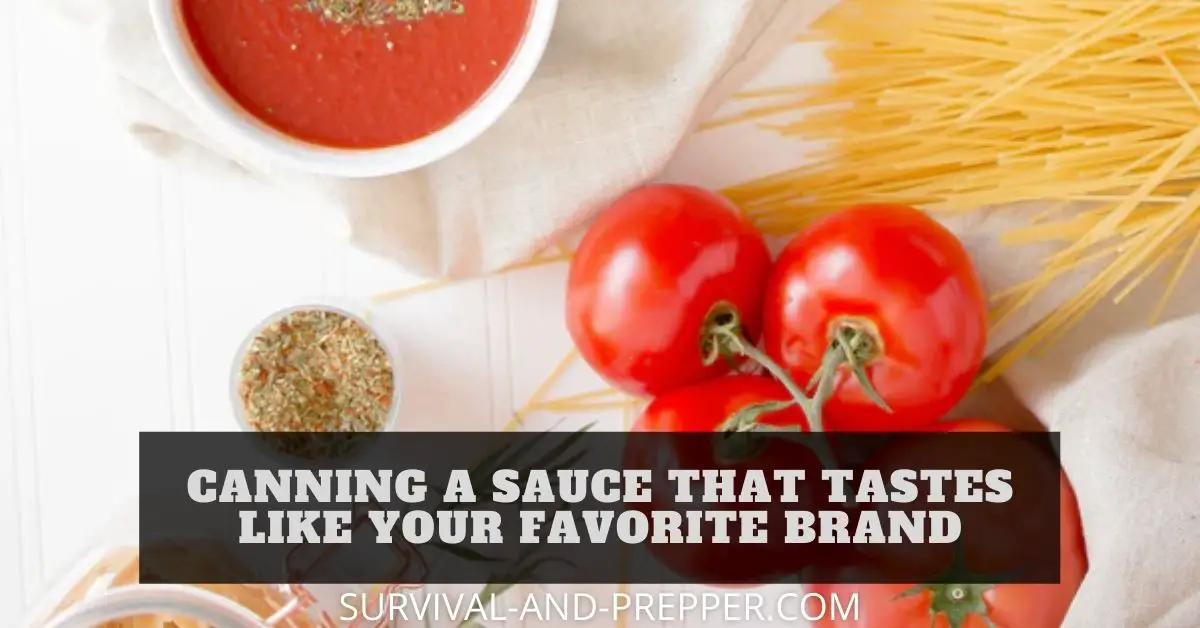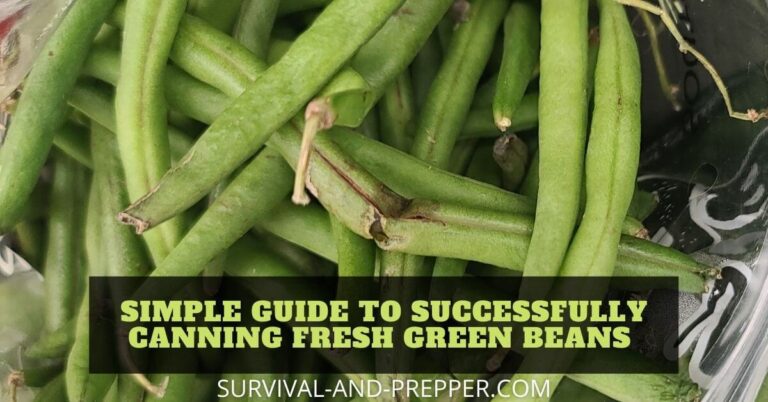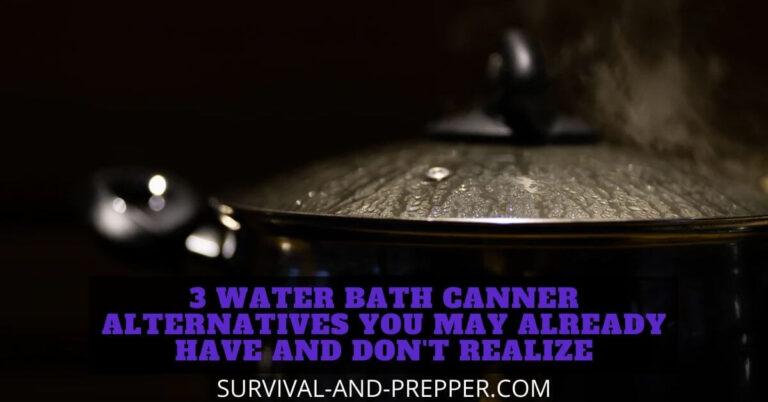Canning A Sauce That Tastes Like Your Favorite Brand
It’s possible to create homemade spaghetti and pasta sauces that taste like your favorite store brand. Start with a meaty tomato and add citric acid for preservation. It is then a simple matter of adding spices for desired taste. Sauces can be preserved with a canner of your choice providing year round flavor.
If your goal is to mimic the flavor of your favorite store bought sauce then there are a few things you should consider.
The first consideration is texture. Often this is greatly affected by the ingredients added to the sauce such as carrots, mushrooms and other vegetables.
Second is the flavor. Many storebrand sauces have ingredients not commonly found in homemade sauces. Preggo sauce for instance has a high amount of sugar. While some may not like this some people really like that sauce.
A third characteristic you should consider is the intended use of the sauce. As you are aware sauces come in several forms; marinara, spaghetti, and tomato soup are all common sauces you will likely encounter that can be made at home from your garden’s harvest.
With that being said, read on to find out the best way to create and then can your sauces for year round flavor.
Before You Begin
In this particular discussion we are covering those thicker sauces such as marinara, spaghetti and pizza. Tomato soup is an entirely different creation and requires a different set of recipes.
Traditionally these type of sauces tend to be thicker and require less work. Marinara sauce is often nothing more than a combination of tomatoes, basil, red pepper and garlic.
Before we begin it is important to note that prolonged time in the canning jars tends to dilute the flavor of your sauce down.
Therefore it is often considered better to make a base sauce for canning, and then add the spices when you actually cook the dish to be consumed. This will allow you to tailor 1 single sauce to multiple dishes.
Another key point to consider as you begin is your tomatoes. According to Wikipedia there are more than 10,000 tomato varieties. With this many options it should be obvious that certain tomatoes make better sauces than others.
For the purpose of making sauces a tomato with a thick meaty skin works the best. While any tomato will work, these will produce the best sauce and require the least amount of cooking time. Some recommended ones include Roma, Amish Paste and San Marzano.
Creating the Sauce Base
Now that you are ready to begin I prefer to make sauces in large batches. If you want to start off with a smaller batch you can half or quarter the following ingredients.
To Make Homemade Spaghetti or Pasta Sauce Start with the Following Ingredients:
- 20 to 25 pounds of tomatoes
- 3 cups of minced onions
- 5 to 6 cloves of fresh garlic
- 4 dry bay leaves
- ¼ cup olive oil
- Black pepper (about 1/2 tablespoon or to taste)
- ½ teaspoon red pepper flakes
- 1 teaspoon of salt (or to taste)
- 1 tablespoon of basil
- Citric Acid or lemon juice (citric acid is preferred as it won’t affect taste)
- Optional 3 to 10 tablespoons of cane sugar
These ingredients will fill around 8 pint or 4 quart jars.
Making Your Sauce is Accomplished In the Following Steps
- In a large stock pot add a portion of your oil, mince the garlic and onions and add to the oil sauteing them until they are soft.
- Wast the tomatoes in cool clean water and then cut into quarters or smaller. Add the tomatoes to your pot of medium to high heat. If you wish to add diced mushrooms now is an ideal time. After about five minutes reduce heat to a simmer. *See Note*
- Remove the tomato mixture from heat and allow it to cool. Once cool you can run the tomatoes through a food mill or blender depending on your desired consistency. A food mill will remove the skins,seeds and smooth the sauce while a blender will leave these behind resulting in a chunkier sauce.
- Return the mixture to the pot and begin simmering again. At this point, add the bay leaves, red pepper, basil, pepper and salt. During the simmer you may want to adjust these slightly and flavor to taste. You will want to simmer for around forty minutes or to the point that the sauce has been reduced by about half.
- Your sauce should be ready to eat if you want to use it directly at this point. Or you can begin the steps to can the sauce for later use.
Canning Your Homemade Spaghetti or Marinara Sauce
Many people can tomatoes and sauces in a water bath canner. Historically this was a relatively safe practice, however, changes in tomato strains has resulted in a lower acidity level for many tomatoes.
Therefore in order to avoid the dangers of botulism you should add either lemon juice or citric acid to increase the acidity of your mixture.
For best results add your citric acid or lemon juice while the mixture is still simmering. You are aiming for a pH level of under 4.6. The best way to do this is to add several drops stir thoroughly and then test using a pH tester.
Safely Canning Your Tomato Sauce in a Waterbath Canner
- While simmering your sauce, boil your jars for 10 minutes to sterilize them and warm your lids in hot water. Keep these warm until ready to use.
- Carefully set your jars on the counter in a stable location ensuring that they have minimal liquid left in them from the warming process.
- Verify the ph level of your sauce. Again you want a reading that is lower than 4.6 (If you did not already add the citric acid or do not have a tester then you can get by by adding ¼ teaspoon of citric acid to each pint jar.)
- Using a funnel or canning ladle fill your jars to about an inch from the top, wipe the rim with a clean cloth
- Set your lids on the jars and add the rings. Tighten the rings down only to snug. Do not over tighten them, they need to be able to lift slightly and allow the air inside of the can to escape, but not so loose that water gets into the jars.
- Place your jars back into the canner and ensure the water level covers the jars by at least one inch. You can use the hot water you warmed your lids in to add more water here if you need.
- Cover the canner and bring the pot to a boil. (This is not pressure canning so the lid should not be sealed on tight.) Allow the water to continue boiling for at least 35 minutes if processing pint jars and 40 minutes for quart jars.
- Remove from the heat source and with the jars remaining in the pot allow it to cool for 10 to twenty minutes. After this carefully remove the jars from the pot and place them on a dry towel. (Due to their temperature a jar lifter is recommended and do not set the jars directly on a granite or marble countertop as they are likely to shatter from the heat difference.)
- Once your jars have cooled for around 24 hours check to see if the jars are sealed. This can be done by pushing the center of the lid. If properly sealed it should not move. If it is not sealed it will make a popping noise. Refrigerate these jars or use within a few days.
- The ones that are sealed can now be labeled and stored how you choose. It is recommended that you remove the rings from the lids and wash the jars. Dry them completely and then label the lid with a sharpie. Removing the rings and allowing the vacuum within the jars to hold the lids on you will be alerted to any issues with your canned foods by the top popping loose.
- When you get ready to use one of your jars of sauce you can tailor it with a bit more italian seasoning, salt and pepper to taste or to match your dish at that time. Seasoning it at the final cooking time will ensure a robust flavor vs one that has become bland with canning.
Tailor Your Recipe to Mimic Your Favorite Store Brand Sauce
In order to match or mimic a branded sauce you need to first determine what it is about that sauce that you like, and what ingredients they use to achieve that desired flavor.
We are going to examine three common store sauces and discuss their ingredients.
Keep in mind that the ingredients are listed in descending order based on amount. So the first item on the list makes up the largest portion of the contents and so on. You can tell when an ingredient changes as they are separated by commas.
Canning a Spaghetti Sauce Similar to Preggo Sauce
The image below contains a snapshot of the ingredients list on Preggo brand pasta sauce.
As you can see the first two ingredients are expected. Tomato Puree and Diced tomatoes. This is very similar to the sauce we made using the recipe above.
However, the third ingredient is a bit unexpected.
Preggo sauces tend to be a bit sweeter than other spaghetti sauces and this is represented by the fact that sugar appears as the third ingredient in the list. With that in mind it stands to reason one of the major ingredients you are going to need to add to your sauces is sugar.
Assuming you are intending to create the entire batch in this manner, you will add around a cup to a cup and a half of sugar to the total batch. (Given the ingredients list from the recipe I posted.) Additionally some onion powder and garlic powder can be added as needed.
Each of these ingredients will be added during the simmering step. I would add these ingredients a small amount at a time during the last 5 minutes or so of the simmering and taste as you do so. This will allow you to tailor the sauce to your desired outcome.
It is likely that anytime you add something the pH level will change so make sure that you verify a safe pH level before you begin adding the sauce to the jars. Remember using citric acid instead of lemon juice will help ensure your flavor is not affected.
What about a Canning Recipe for Ragu Style Sauce?
Similar to how we examined the label on the Preggo sauce we can look at one for Ragu another common brand found in stores. The label below is from a jar of Ragu Sauce in my local supermarket.
As I expected the first two ingredients were similar to the Preggo Sauce. We have a tomato puree and tomatoes.
However, when we reach the third ingredient things change somewhat. Instead of sugar we now have salt with sugar appearing a bit further down the list. This means that the sugar makes up a smaller portion of this particular sauce.
In order to tailor your sauce to match this flavor I would add a tablespoon of sea salt, a half cup of soybean or canola oil, a ¼ cup of sugar and ½ cup of grated parmesan cheese.
Add these ingredients during the last five minutes of the simmer stage and taste. Make minor adjustments to reach the desired taste as you go.
Once you have reached your desired taste remember to verify the pH level and can your sauce as before.
The Final Canning Recipe We Are Going to Examine Is Bertoli
Similar to the other two we are going to examine the ingredients on the below image. One thing to note, Bertoil tends to be slightly chunkier than the other two options we looked at. You can replicate this by adding some additional tomatoes that have not had their peelings removed.
(I suggest you rinse the seeds out after slicing the tomatoes or it ends up having more of a salsa consistency to me.)
Examining the label here we see ingredients similar to those found in Preggo, which is to be expected since Bertoli is a bit sweeter than say ragu. However if you continue to read you see that they go more in depth about what spices they use.
You can see basil, and parsley in addition to the garlic.
To get close to this sauce I would go with 1 cup of sugar, a tablespoon of parsley, a teaspoon of basil (tends to be overpowering if using dried so go light) and some garlic powder.
Like before add these ingredients and the chunkier tomatoes during the final simmer phase. Adjust to taste and can as before.
In Conclusion
While it is very difficult to exactly match the flavor of a store bought sauce, you can come very close by examining their ingredients list.
However, the main advantage to making your own sauces is that you don’t have to eat the store bought brands. You can use their recipe as a base idea, but then tailor it to your specific liking.
By using high quality and fresh ingredients you can create a sauce that is far superior to those you buy in the store.
If you are going to experiment with flavors then start with a large batch and separate it into several smaller amounts. That way you can try out seasoning amounts as you go without ruining an entire batch if you do not like the outcome.
Now get out there, experiment and multiple your stockpiles with your new canning knowledge!


![Hot Pack Canning vs Cold Pack Canning [What’s the Difference]](https://survival-and-prepper.com/wp-content/uploads/2021/03/Hotpack-v-cold-pack-768x402.jpg)



![Heat and Your Mason Jars [ 9 ] Top Questions & The Answers](https://survival-and-prepper.com/wp-content/uploads/heat-and-mason-jars-768x402.jpg)